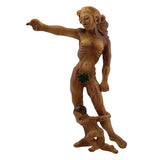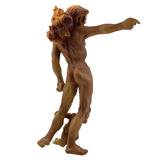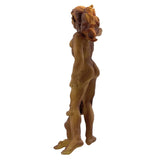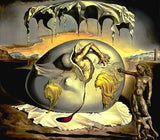Protection Mother Figurine from Geopolitical Child Birth of New Human by Salvador Dali 4H
PN# SD010-womanThis woman statue adaptation of The Birth of the New Human (1943) is taken from a painting by Salvador Dali in which he illustrates a plea for a radical liberation from the oppressive entwining from the past. A frightened child at the woman's knees, seeks protection from its mother.
The Spanish artist Dali is well known for his Surrealist, dream-like, intermixing of the ordinary and the extraordinary. This sculpture is part of a series of statue adaptations of Salvador Dali's work from the Parastone Mouseion 3D Collection of museum masterpiece collectibles.
Lady is a small scale figurine made from resin with hand-painted details. Measures: 4 in H x 2 1/4 in W x 1 in D. Weight: 3 ounces. PN# SD10-woman.
ABOUT DALI AND SURREALISM: Dali sublimated his life in his art of painting. Relying on great craftsmanship, acquired in all sorts of art experiments, he lifted surrealism, in an inimitable self-willed manner, to exceptional heights. As it were, he photographed associatively what was enacted in his mind. Incited by, at the time, new psychological insights he tried to fix his subconscious with images and to visualize his dreams in all their inscrutable symbolism. For this purpose, he developed his famous "paranoid-critical" method. To us, one-dimensional mortal souls, only the paintings and other expressions remain fascinating witnesses to an unbelievably intense and active life. Perhaps we are so drawn to them because not only do they allow us to have a look inside Dali's subconscious, but they also are a mirror reflecting our own souls. In the opening sentences of his manifest which was published some years before Dali says, "When during the history of its culture a people feel the need to cut the ties with which it is bound to the logical systems of the past in order to obtain an independent mythology - a mythology which perfectly fits its essence and its total expression of their biological reality and is recognized by the higher elite - then public opinion demands from the pragmatic society, considering its own systematic, that the motives for such a split is enlightened with traditional and worn out formulas.













